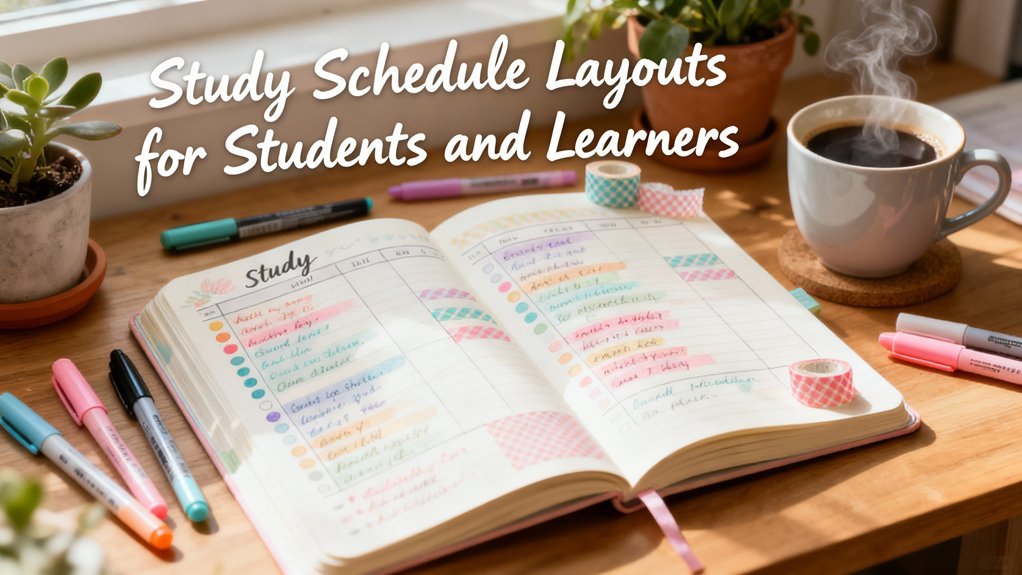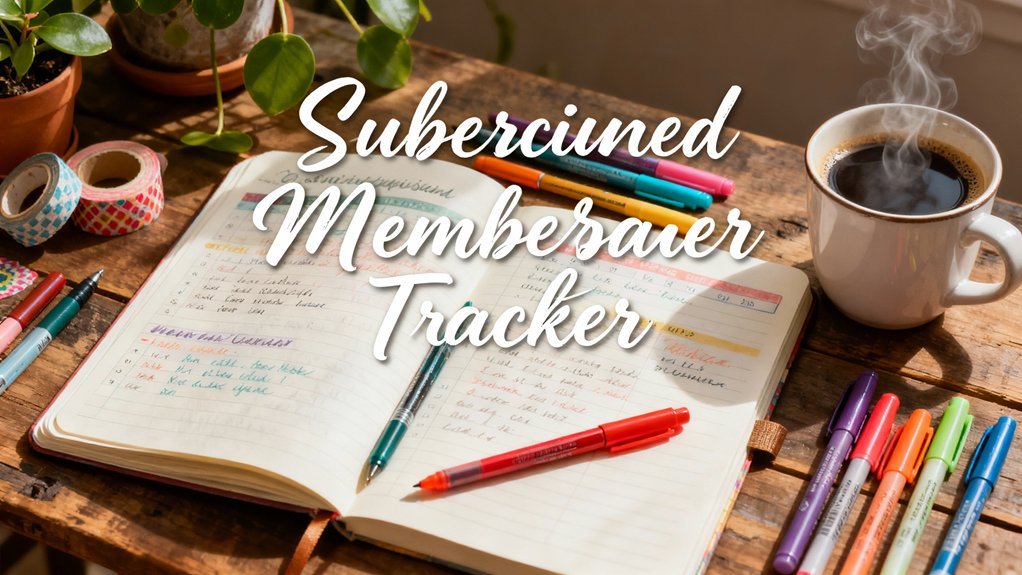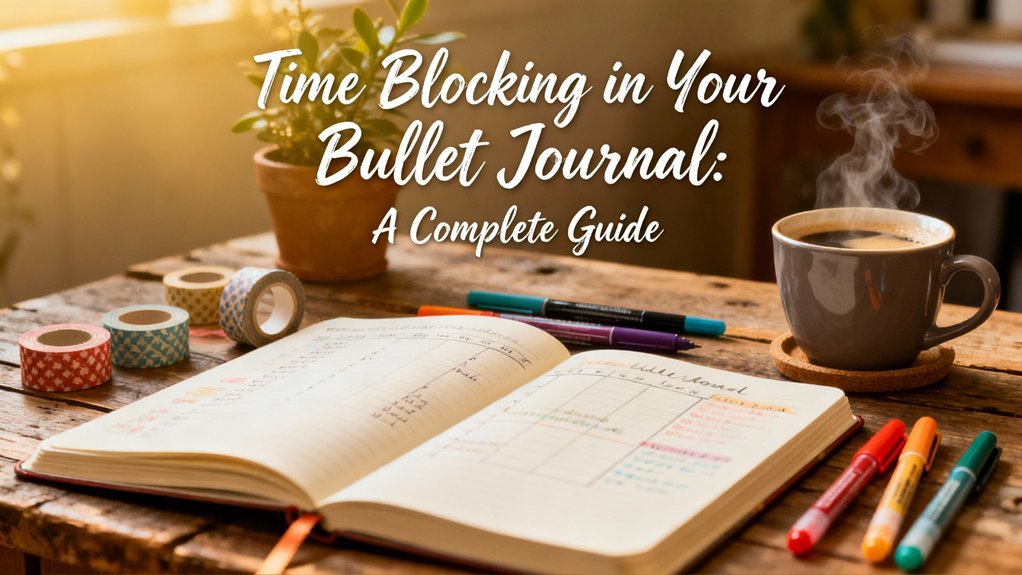Your study schedule should integrate time-blocking frameworks like the Pomodoro Technique with visual organization systems—color-coding subjects and highlighting priorities through methods like the ABC classification or Eisenhower Matrix. You'll optimize retention by aligning your layout with your dominant learning style (visual, auditory, kinesthetic, or reading-writing) while incorporating strategic breaks: 25-50 minute sessions with 5-10 minute microbreaks, or 90-minute deep work blocks with 15-20 minute active rest. Digital tools offer improved flexibility for real-time adjustments, and the following sections reveal how to personalize these frameworks for sustainable academic performance.
Key Takeaways
- Time-blocking frameworks like Pomodoro Technique and day theming help students structure study periods according to cognitive patterns and course demands.
- Color-coded systems and ABC Priority Classification create visual hierarchies that improve memory retention and direct attention to critical tasks.
- Digital tools offer enhanced flexibility with calendar integration and customizable templates that synchronize schedules across multiple devices seamlessly.
- Strategic breaks between study sessions restore mental resources, with ratios like 25-50 minutes focused work followed by 5-10 minute recovery.
- Buffer blocks and makeup protocols address scheduling disruptions while tracking actual versus planned time identifies patterns for sustainable consistency.
Understanding Different Time-Blocking Frameworks and Their Applications

When researchers examine effective study behaviors, time-blocking consistently emerges as a strategy that improves academic performance and reduces procrastination. You'll find several frameworks worth exploring as you develop your time management approach.
The Pomodoro Technique segments your work into 25-minute intervals with short breaks, capitalizing on sustained attention spans. Time-boxing allocates fixed periods to specific tasks, preventing perfectionism from derailing your progress. Day theming dedicates entire days to particular subjects, allowing deep immersion in content.
Each framework offers distinct advantages for different learning contexts. Pomodoro excels for combating focus fatigue, while time-boxing suits project-based assignments. Day theming works exceptionally well during intensive exam preparation.
Your selection should align with your cognitive patterns and course demands. Research indicates that students who match productivity techniques to their natural rhythms achieve better outcomes than those following generic prescriptions.
Experiment systematically to identify which framework enhances your learning efficiency.
Visual Organization Methods: Color-Coding and Spatial Planning Techniques
Research demonstrates that visual organization strategies greatly improve memory retention and task completion rates among students.
You can implement color-coded subject categories to reduce cognitive load while processing your schedule, assign specific colors to time blocks for quick visual scanning, and use highlighting systems to distinguish high-priority tasks from routine activities.
These spatial planning techniques activate your brain's visual processing centers, making schedule information 40% easier to recall than text-only formats.
Color-Coded Subject Categories
Implement these evidence-based strategies:
- Assign warm colors (red, orange) to analytical subjects like mathematics and physics, leveraging their association with alertness and problem-solving states.
- Designate cool colors (blue, green) for language-based disciplines, capitalizing on their calming effects that improve reading comprehension and creative writing.
- Reserve high-contrast colors (yellow, purple) for priority deadlines, creating immediate visual hierarchy that prevents overlooked commitments.
This systematic approach alters your schedule into a self-explanatory cognitive map, eliminating decision fatigue while optimizing information retrieval.
Time Blocking Visual Maps
By translating your daily commitments into spatial representations, you create neurological anchors that convert abstract time concepts into concrete, manageable units.
Time blocking visual maps utilize visuospatial processing to improve your executive functioning and reduce cognitive load during planning phases.
Research demonstrates that spatial time allocation activates different neural pathways than traditional list-making, strengthening memory formation and task initiation.
You'll implement advanced scheduling techniques by assigning physical dimensions to your study blocks—width represents duration, height indicates priority levels, and positioning shows sequential relationships.
This methodology alters temporal planning from passive recording into active architecture.
Your brain processes these visual frameworks more efficiently than text-based schedules, enabling rapid pattern recognition and adaptive rescheduling.
Strategic spatial mapping accelerates your shift from planning to execution.
Priority Highlighting Systems
Visual frameworks gain maximum effectiveness when paired with systematic priority indicators that direct cognitive attention toward high-impact activities.
You'll improve learning outcomes by implementing structured highlighting systems that distinguish between priority levels and task urgency through deliberate visual cues.
Research-validated approaches include:
- ABC Priority Classification – Assign A-level markers to critical deadline-driven tasks, B-level to important-but-flexible activities, and C-level to supplementary learning opportunities that boost comprehension without immediate consequences.
- Eisenhower Matrix Integration – Map assignments across urgent-important quadrants, enabling you to distinguish between reactive studying and strategic knowledge-building.
- Color-Temperature Encoding – Apply warm hues (reds, oranges) to high-stakes examinations and cool tones (blues, greens) to developmental practice sessions.
These evidence-based systems convert generic schedules into cognitive navigation tools that accelerate decision-making and reduce mental fatigue. The Bullet Journal Method enhances these visual systems by helping you track the past, organize current priorities, and plan future learning objectives through reflective writing practices that clarify what truly matters in your academic journey.
Customizing Your Schedule Based on Learning Style and Academic Goals
Your brain processes information differently depending on whether you're a visual, auditory, kinesthetic, or reading-writing learner—a framework supported by VARK learning preferences research.
Matching your study schedule to your dominant learning style increases retention by up to 40% compared to generic study plans.
Start by completing a learning style assessment, then allocate your peak cognitive hours (typically 2-4 hours after waking) to your most challenging academic goals that require your specific learning approach.
Identify Your Learning Type
Understanding how you naturally process and retain information forms the foundation for building an effective study schedule.
Research on multiple intelligences reveals distinct learning modalities that directly impact your academic performance. You'll enhance your study time by aligning activities with your dominant type:
- Visual learning: Alter complex concepts into diagrams, mind maps, and color-coded notes that make abstract ideas tangible and memorable.
- Auditory learning: Record lectures, discuss topics aloud, and use podcasts to absorb information through sound patterns your brain naturally prefers.
- Kinesthetic learning: Incorporate movement, hands-on experiments, and physical models to engage your body's role in memory formation.
- Reading writing learning: Utilize written summaries, extensive note-taking, and text-based resources to deepen comprehension.
Identifying your type isn't about limitation—it's about strategic resource allocation.
Align Goals With Time
Once you've identified your learning type, the next critical step converts that self-knowledge into a functional time-management system. Research shows that effective goal setting strategies require temporal alignment—matching your objectives with realistic time blocks.
Begin by categorizing goals into short-term (weekly), medium-term (monthly), and long-term (semester) targets. Cognitive load theory suggests breaking complex academic goals into manageable chunks that fit your energy patterns. Visual learners might allocate longer sessions for diagram creation, while kinesthetic learners benefit from frequent, movement-integrated intervals.
Time management techniques like time-blocking and the Pomodoro method work best when customized to your learning preferences. Track your productivity patterns for two weeks, then adjust schedules accordingly. This data-driven approach converts generic planning into personalized academic architecture.
Digital Tools and Templates for Building Dynamic Study Plans

While paper planners retain certain advantages, digital tools have fundamentally altered how learners create and maintain study schedules through features that respond to changing circumstances.
Research demonstrates that digital planners improve adherence rates by providing adaptive frameworks that accommodate unexpected shifts in workload or comprehension speed.
Digital planners enhance commitment through flexible structures that adjust to fluctuating academic demands and individual learning pace variations.
Template customization allows you to construct systems aligned with your cognitive patterns rather than forcing adaptation to rigid structures.
Consider these life-changing capabilities:
- Automated rescheduling algorithms that redistribute uncompleted tasks across available time blocks, eliminating the frustration of manual replanning.
- Progress analytics dashboards that reveal productivity trends, enabling you to fine-tune peak performance windows.
- Cloud synchronization features that maintain schedule accessibility across devices, ensuring continuity regardless of location.
These innovations transcend traditional planning limitations by creating responsive ecosystems that evolve with your learning journey.
The integration of artificial intelligence and machine learning continues expanding possibilities for personalized schedule enhancement based on individual performance data.
Balancing Study Sessions With Rest, Activities, and Personal Time
Because cognitive performance deteriorates without adequate recovery periods, effective study schedules must integrate strategic breaks that restore mental resources rather than simply filling gaps between work sessions. You'll enhance retention by implementing structured study breaks using the Pomodoro Technique or 90-minute ultradian cycles aligned with natural attention spans.
| Time Block | Activity Type | Recovery Method |
|---|---|---|
| 25-50 min | Focused study | 5-10 min microbreak |
| 90 min | Deep work | 15-20 min active rest |
| 3-4 hours | Study marathon | 45-60 min full disconnect |
Incorporate evidence-based relaxation techniques: progressive muscle relaxation, mindfulness meditation, or brief cardiovascular movement. You're not sacrificing productivity—you're optimizing consolidation processes that occur during downtime. Schedule non-negotiable personal activities as fixed appointments, treating leisure with the same respect as academic commitments. This approach prevents burnout while enhancing neuroplasticity, creating sustainable learning patterns that adapt to your evolving cognitive demands. Consider working with certified GTD coaches who can help you design personalized study systems that balance academic commitments with recovery needs.
Troubleshooting Common Scheduling Challenges and Maintaining Consistency

Consider these evidence-based strategies for sustained consistency:
- Implement the “buffer block” technique—schedule 15-minute adjustment periods between study sessions to absorb inevitable delays without derailing your entire day.
- Create “makeup protocols” that specify exactly when and how you'll recover missed sessions, eliminating guilt-driven procrastination cycles.
- Track your actual versus planned time weekly, identifying patterns in your deviations to redesign unrealistic expectations.
Effective time management isn't about rigid adherence—it's about building flexible systems.
When disruptions occur, you're prepared with predetermined responses rather than improvising under stress. This developmental approach alters scheduling from a restrictive obligation into an evolving tool supporting your growth.
Frequently Asked Questions
How Do I Create a Study Schedule if I Have Unpredictable Work Hours?
You'll need flexible planning that adapts to your shifting schedule.
Research shows time blocking works best when you create multiple study templates for different work scenarios. Block out 2-3 priority subjects you'll tackle whenever free hours emerge, rather than fixed daily slots.
Use micro-sessions of 25-30 minutes that fit unpredictable gaps. Track your actual available hours weekly, then redesign your blocks accordingly.
This adaptive approach maintains consistency while honoring your variable reality.
Should I Study the Same Subjects at the Same Time Every Day?
You don't need identical timing daily—research shows subject rotation actually improves learning through varied neural activation.
However, daily consistency in *having* dedicated study blocks matters more than when they occur. Consider time-of-day cognitive patterns: tackle complex subjects during your peak alertness periods.
Creative learners mix strategic repetition with deliberate variation, optimizing memory consolidation while preventing mental fatigue.
You'll develop stronger metacognitive skills by flexibly adapting your schedule while maintaining regular study rhythms.
How Long Does It Take to Form a Consistent Study Habit?
Research shows you'll need 18-254 days for habit formation, with 66 days being the average.
Your study duration consistency matters more than perfection—missing one day won't derail progress. Start with manageable 15-20 minute sessions and gradually increase.
You'll notice automaticity developing around the 3-week mark, but don't stop there.
Brain plasticity research confirms that sustained practice over 8-10 weeks creates strong neural pathways, making your study routine feel easy and natural.
Can I Effectively Study Multiple Subjects in One Session?
Yes, you can study multiple subjects effectively in one session using strategic multitasking techniques.
Research shows interleaving—switching between related subjects—enhances long-term retention better than blocked practice.
Apply subject prioritization by scheduling demanding topics when you're most alert, then alternating with lighter material.
Space subjects 25-50 minutes apart with brief breaks.
This approach strengthens neural connections and prevents cognitive fatigue, making your study sessions more productive and groundbreaking.
What Should I Do When Family Obligations Disrupt My Study Schedule?
When family obligations disrupt your schedule, you'll need flexible time management strategies. Research shows that prioritizing tasks by urgency and importance helps you adapt without losing momentum.
Create buffer zones in your study plan for unexpected interruptions, and communicate your academic needs clearly with family members. You can't eliminate disruptions, but you'll maintain progress by rescheduling—not abandoning—your study blocks.
Consider micro-learning sessions during fragmented time to enhance productivity despite interruptions.
Conclusion
You've explored the building blocks of effective scheduling—from time-blocking frameworks to digital tools that adapt as you grow. Like Goldilocks finding what's “just right,” you'll discover your ideal balance through experimentation. Research confirms that personalized schedules, grounded in your learning style and punctuated with adequate rest, improve both retention and well-being. Don't expect perfection immediately; sustainable study habits develop gradually. Start small, adjust consistently, and you'll build a system that truly works for your academic journey.











